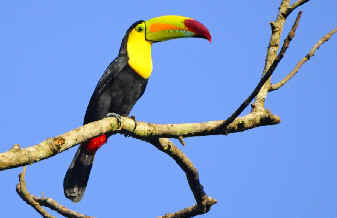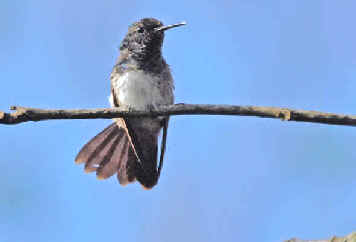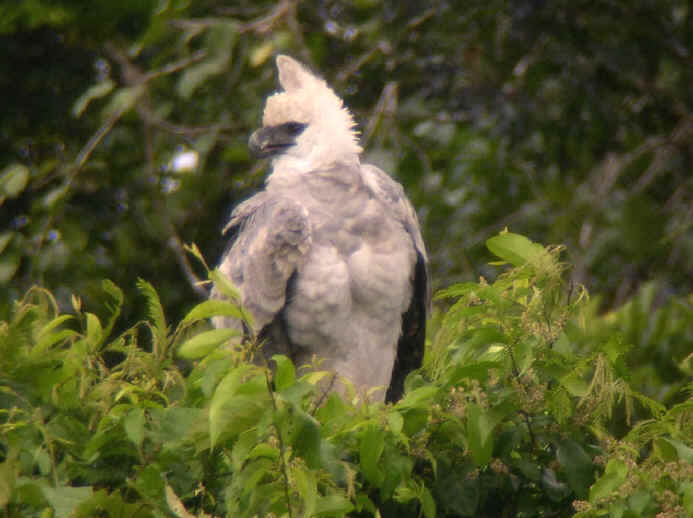
PANAMA
BIRDS
noting those found during
Focus On Nature Tours
1998 thru 2015
during the months of
February,
March, July, August,
October and November

The following list of Panama Birds
compiled by Armas Hill
Photos at right: KEEL-BILLED TOUCAN
(above)
and SNOW-BELLIED HUMMINGBIRD (below)
(Both photos by Marie Grenouillet)
In the list that follows, there are about
60 different species of hummingbirds.
Among the links below, there is one to a list
of all the hummingbirds, with photos of many.
There have been 10 FONT birding tours in
Panama.
596 species of birds have cumulatively been seen.
Codes:
(PNe): endemic to Panama
(PNi): introduced species in Panama
(t): a globally threatened or
rare species, designated by Birdlife International.
(t1):
critically endangered (t2):
endangered (t3): vulnerable
(nt): a near-threatened species
globally
(PNt): a nationally threatened species in Panama
(t1):
critically endangered (t2):
endangered (t3): vulnerable
(PNnt): in Panama, a nationally near-threatened species
(PNr): rare, or very rare in Panama
(ph): species with photo in the FONT website
In the following list, these codes below when blue relate to birds during FONT
tours. Otherwise, these codes are gray.
CB: the Panama Canal Basin, including areas of Panama City, Gamboa, Pipeline and
Plantation Roads, Barro Colorado Island, and various other nearby places in the Soberania and Chagres National Parks.
On the Caribbean side of the Canal Basin, locations include: the Escobal &
Achiote Roads, Fort Sherman, Isla Gaviota, and Sierra Llorona.
Species with an (mp) have occurred at the
Metropolitan Park in Panama City. An (r) is a
rarity there.
Species with an (sp) have occurred in the Soberania
National Park, including Gamboa & the Pipeline Road.
Again, an (r) is a rarity there. (v)
is a vagrant.
CH: highlands in
Chiriqui province, in western Panama
CL: lowlands in Chiriqui province, in western Panama
DL: lowlands in Darien, in eastern Panama
(DN: in Darien in
general)
EP: eastern Panama province
Links to Groupings of Birds in this List:
Tinamous Chachalacas, Guans,
Curassow Wood Quails, Bobwhite
Waterfowl Seabirds
Grebes Ibises, Spoonbill, Stork
Bitterns,
Herons, Egrets
Tropicbirds, Pelicans, Boobies
Cormorants & Anhinga
Raptors Rails &
Allies Shorebirds
Jaegers, Gulls, Terns
Pigeons, Doves
Macaws, Parakeets, Parrots
Cuckoos
Owls Potoos,
Nighthawks, Nightjars
Swifts
Hummingbirds Trogons Kingfishers
Motmots
Jacamars Puffbirds
Barbets
Toucans Woodpeckers Tityras, Becards
Cotingas Manakins
Tyrant-Flycatchers
Antbirds Tapaculos Antthrushes, Antpittas
Furnariids Woodcreepers
Vireos Jays
Waxwing & Allies
Swallows, Martins Wrens Gnatcatchers, Gnatwrens
Thrushes
Mockingbird, Catbird Dipper
Pipit Chlorophonias, Euphonias
New
World Warblers
Icterids
Bananaquit
Finches,
Sparrows Tanagers
Conebill, Dacnis, Honeycreepers
Finches, Grassquits, Seedeaters Dickcissel, Saltators,
Grosbeaks, Buntings
Other Links:
A
List & Photo Gallery of Central American Birds, in 4 parts
Panama Mammals
Mammals
in Central America (with
some photos)
A
List & Photo Gallery of Central American Butterflies & Moths, in 6 parts
Hummingbirds, a 2-part list of them all
(with some photos)
Directory
of Photos in the FONT Website
Highlights
of some previous FONT tours in Panama
Upcoming
FONT Birding & Nature Tours in Central America
Chronological
Listing of upcoming FONT Tours Elsewhere


Above: a JUVENILE HARPY EAGLE
Between October 2000 & December 2006, nests were found in Panama
of 25 breeding pairs of Harpy Eagles in the province of Darien.
Most were in tropical rain forest at an average altitude
of nearly 400 feet above sea level, ranging in elevations
from 150 to about 900 feet.
Nest densities are estimated to be 4 to 6 in about 50 square miles.
Each breeding pair occupies from 8 to 12 square miles of forest.
This nesting density of Harpy Eagles is the highest that's known
for the species throughout its entire breeding range.
The Harpy Eagle is the national bird
of Panama.
Bird-List:
- Great Tinamou (nt) (*) ______
CB sp DL EP
Tinamus major castaneiceps
- Little Tinamou (*) ______ CB
mp sp
CH DL EP
Crypturellus soui poliocephalus
- Choco Tinamou (t3) (PNt2) ______
Crypturellus kerriae
- Highland Tinamou (PNt2) ______
Nothocercus bonapartei
CHACHLACA, GUANS, CURASSOW
- Gray-headed Chachalaca (*) ______
CB mp sp CH CL DL
Ortalis cinereiceps
(monotypic)
- Black Guan (nt) (PNt3) ______
(total range limited to Costa Rica & western Panama)
Chamaepetes unicolor
- Crested Guan (PNt3) (ph) (*) ______
CB sp(r)
Penelope purpurascens aequatorialis
- Great Curassow (nt) (PNt3) (*) ______
CB sp(r)
Crax r. rubra
WOOD QUAILS & BOBWHITE
- Marbled Wood Quail (nt) (PNt3) (*) ______
CB sp
Odontophorus gujanensis marmoratus
- Black-eared Wood Quail ______
Odontophorus melanotis
The Black-eared Wood Quail is closely related to and has been
considered conspecific with the Rufous-fronted Wood Quail, Odontophorus
erythrops, of South America, occurring in nearby Colombia.
There has been no evidence of intergradation between O.
melanotis & O. erythrops.
- Black-breasted Wood Quail (PNt3) ______
Odontophorus leucolaemus
- Tacarcuna Wood Quail (t3) (PNt2) ______
DN
Odontophorus dialeucos
The Tacarcuna Wood Quail was discovered in 1963. It is known
only on Tacarcuna Ridge in the Darien of Panama & adjacent Colombia.
- Spotted Wood Quail _______
Odontophorus guttatus
- Tawny-faced Quail ______
CB sp(r)
Rhynchortyx cinctus
- Crested Bobwhite (*) ______
DL
Colinus cristatus (2 subspecies in Panama)
Colinus cristatus mariae
(subspecies in northwest Panama, in Chiriqui)
Colinus cristatus panamensis (subspecies in southwest
Panama)
The Crested Bobwhite has been considered by some to be
conspecific with the more-northerly Spot-bellied Bobwhite.
WATERFOWL
- Black-bellied Whistling Duck (PNt3)
(ph) (*) ______ CB sp CL
DL EP
Dendrocygna a. autumnalis
- Fulvous Whistling Duck (*) ______
Dendrocygna bicolor
(monotypic)
- White-faced Whistling Duck (PNr)
(PNt1) (ph) ______ CB sp(v)
Dendrocygna viduata
- Muscovy Duck (PNt3) (ph) (*) ______
CB sp
Cairina moschata (monotypic, and the single member of its genus)
- Comb Duck (PNt1) ______
Sarkidiornis syvicola
The Comb Duck was conspecific with what is now the Knob-billed
Duck of Asia & Africa.
- Blue-winged Teal (ph) (*) ______
CB sp CL
Anas discors (monotypic)
- Mallard (PNr) (ph) ______
(a wild bird, not escaped domestic stock, would be a vagrant in Panama)
Anas platyrhynchos
There was a Panamanian record of a Mallard on the Pacific side of the
Canal Area in 1992.
- White-cheeked Pintail (PNr) (ph) ______
(a vagrant in Panama)
Anas bahamensis
- Northern Pintail (PNr) (ph) ______
Anas acuta
There have been very few records of the Northern Pintail in
Panama. A pair was seen in the Canal Basin in December 1997.
- Green-winged Teal (PNr) (ph) ______
CB (a vagrant in Panama)
Anas carolinensis
There was a Panamanian record of a male Green-singed Teal in
the Canal Basin in December 1996.
- Cinnamon Teal (PNr) ______
Anas cyanoptera
In September 2003, several Cinnamon Teal was present near
Panama City, at Costa del Este, in September 2003.
They continued in that area for a few weeks.
- Northern Shoveler (PNr) (ph) ______
Anas clypeata
2 Northern Shovelers were near Panama City. at Costa del Este,
in October 1997.
- American Wigeon (ph) ______
CB sp(r)
Anas americana
- Ring-necked Duck (ph) ______
CB sp(r)
Aythya collaris
- Lesser Scaup (ph) ______
CB sp
Aythya affinis
- Masked Duck (PNt3) ______
CB sp
Nomonyx dominicus
SEABIRDS
- Galagagos Penguin (t2) (PNr)
_____ (a vagrant in Panama)
Spheniscus mendiculus
There was a record of a Galapagos Penguin along the Chiriqui coast in
1955, at Puerto Armuelles.
- Wandering Albatross (t3) (PNr) ______
(offshore, a vagrant in Panama)
Diomedes exulans
- Waved Albatross (t1) (PNr) (ph) ______
(offshore, a vagrant in Panama)
Phoebastria irrorata
Two reports of the Waved Albatross in Panamanian offshore
waters of the Pacific Ocean were in February 1941 west on Pinas Bay in
Darien, and in September 1964 southwest of the Pearl Islands.
- Gray-headed Albatross (t3) (PNr) ______
(offshore, a doubtful record in the 19th Century)
Thalassarches chrysostoma
- Galapagos Petrel (t1) ______
Pterodroma phaeopygia
The Galapagos Petrel was part of the former Dark-rumped
Petrel when it was conspecific with the Hawaiian Petrel.
- Parkinson's (or Black) Petrel (t3)
______
Procellaria parkinsoni
- Cory's Shearwater (PNr) (ph) ______
(offshore, a vagrant in Panama)
Calonectris diomedea
There was a record of a Cory's Shearwater off the Caribbean
coast north of Colon in 1985.
- Wedge-tailed Shearwater ______
Puffinus pacificus
- Sooty Shearwater (ph) ______
Pufinus griseus
- Christmas Shearwater (PNr)
_____ (offshore, a vagrant in Panama)
Puffinus nativitatis
There was a record of the Christmas Shearwater far offshore off
the western Pacific coast in 1990.
The Christmas Shearwater resembles the Sooty Shearwater.
- Townsend's Shearwater (t1) ______
(offshore, a vagrant in Panama)
Puffinus auricularis
- Audubon's Shearwater (PNt2) (ph) ______
Puffinus iherminieri
- Galapagos Shearwater _____
Puffinus subalaris
Until recently, the Galapagos Shearwater was a subspecies of
the Audubon's Shearwater.
- Manx Shearwater (PNr)
______ (offshore, a vagrant in Panama)
Puffinus puffinus
There was a record of a Manx Shearwater at Isla Margarita off
the Caribbean cost, near Colon, in 2003.
- Wilson's Storm Petrel (PNr) (ph) ______
(offshore, a vagrant in Panama)
Oceanites oceanicus
There was a record of a Wilson's Storm Petrel by the Pearl
Islands in 1969.
- White-vented Storm Petrel (PNr) ______
(offshore, a vagrant in Panama)
Oceanites gracilis
- Wedge-rumped Storm Petrel ______
Oceanodroma tethys
- Black Storm Petrel ______
Oceanodroma melania
- Markham's Storm Petrel (PNr) ______
(offshore, a vagrant in Panama)
Oceanodroma markhami
- Least Storm Petrel ______
Oceanodroma microsoma
GREBES
- Least Grebe (ph) (*) ______
CB sp
CL
Tachybaptus
(formerly Podiceps) dominicus brachypterus
- Pied-billed Grebe (*) ______
CB sp CL
Podilymbus podiceps
(2 subspecies in Panama)
Podilymbus p. podiceps (subspecies in western Panama)
Podilymbus podiceps antarcticus (subspecies in eastern
Panama)
IBISES, SPOONBILL, STORKS
- American White Ibis (ph) (*) ______
CB CL DL
Eudocimus albus
(monotypic)
- Scarlet Ibis (ph) ______
Eudocimus ruber
- Glossy Ibis (ph) (*) ______
Plegadis falcinellus
(said to be monotypic)
- Green Ibis ______ CB
sp(v)
Mesembrinibis cayennensis
- Buff-necked Ibis (ph) ______
Theristicus caudatus
- Roseate Spoonbill (ph) ______
Ajaia ajaja
- Wood Stork (ph) (*) ______
CB mp(r) sp(r) CL
DL EP
Mycteria americana
(monotypic)
- Jabiru (ph) ______
Jabiru mycteria
BITTERNS, HERONS, EGRETS
- Least Bittern (ph) ______
CB sp
Ixobrychus exilis
- American Bittern (PNr) (ph) ______
(a vagrant in Panama)
Botaurus lentiginosus
There was a record of an American Bittern in the Canal Area in
1862.
- Rufescent Tiger Heron (ph) (*) ______ CB
sp
Tigrisoma l. lineatum
- Bare-throated Tiger Heron (PNt3) (ph) (*) ______ CL
Tigrisoma mexicanum
(monotypic)
- Fasciated Tiger Heron ______
CB sp(r)
Tigrisoma fasiatum
- Agami Heron (nt) (ph) (*) ______
CB sp(r) DL
Agamia agami (monotypic, and the single member of its genus)
Another name for the Agami Heron is the Chestnut-bellied
Heron.
- Capped Heron (ph) (*) ______
DL
Pilherodius pileatus (monotypic, and the single member
of its genus)
- Cocoi Heron (ph) (*) _____ CB
sp(r)
Ardea cocoi (monotypic)
- Great Blue Heron (*) ______
CB sp CL DL
Ardea h. herodias
- Great Egret (ph) (*) ______
CB mp sp CH CL DL EP
Casmerodius (has been Ardea) alba egretta
- Snowy Egret (ph) (*) ______
CB sp CH CL DL EP
Egretta t. thula
- Little Blue Heron (ph) (*) ______
CB sp CL DL EP
Egretta caerulea
(monotypic)
- Tricolored Heron (ph) (*) ______
CB sp DL
Egretta tricolor ruficollis
The Tricolored Heron was called the Louisiana
Heron.
- Reddish Egret (ph) ______
Egretta rufescens
- Western Cattle Egret (ph) (*) ______
CB mp sp CH CL DL EP
Bubulcus ibis
The Western Cattle Egret is in parts of Europe &
Africa, and now in much of the Americas. The Eastern Cattle Egret, Bubulcus
coromandus, is in eastern Asia.
- Green Heron (*) (ph) ______ CB
sp
CL DL
Butorides v. virescens
The Green Heron, of North America & much of Central
America, was at one time considered conspecific with the
nearly-cosmopolitan Striated Heron (below), and it was then
called the Green-backed Heron.
- Striated Heron (ph) (*) ______
CB sp EP
Butorides s. striata
- Boat-billed Heron (ph) (*) ______ CB
sp
Cochlearius cochlearius panamensis
- Black-crowned Night Heron (*)
______ CB sp CL
Nycticorax nycticorax hoactli
- Yellow-crowned Night Heron (ph) (*) ______
CB mp EP
Nyctanassa violacea caliginis
(the single member of its
genus)
TROPICBIRDS, FRIGATEBIRDS, PELICANS, BOOBIES
- White-tailed Tropicbird (PNr) (ph) ______
(a vagrant in Panama)
Phaethon lepturus
Two records of the White-tailed Tropicbird off the Caribbean
coast of Panama have been in 1936, and more recently 20 kilometers east of
the Bocas del Toro coast in March 1990.
- Red-billed Tropicbird (PNt2) (ph) ______
Phaethon aethereus
- Magnificent Frigatebird (ph) (*) ______ CB
mp sp
CL DL
Fregata magnificens
(now said to be monotypic)
- Great Frigatebird (PNr)
______ (a vagrant in Panama)
Fregata minor
Male and female Great Frigatebirds, one of each, were seen and
photographed 240 kilometers offshore from Coiba Island in November
2013.
The species may occur somewhat regularly in those far offshore Panamanian
waters of the Pacific Ocean.
- Brown Pelican (ph) (*) ______
CB mp sp CL DL
Pelecanus occidentalis carolinensis
- American White Pelican (ph) ______
Pelecanus erythrorhynchos
- Brown Booby (ph) (*) ______
CB sp(r)
Sula l. leucogaster
(subspecies in the
Caribbean)
Sula leucogaster etesiaca (subspecies in the Pacific)
- Blue-footed Booby (*) ______ CB
Sula n. nebouxii
- Masked Booby ______
Sula dactylatra
- Nazca Booby (ph) ______
Sula granti
- Peruvian Booby ______
Sula variegata
- Red-footed Booby (PNr) (ph) ______
CB sp(v)
Sula sula
CORMORANTS & ANHINGA
- Neotropic Cormorant (ph) (*) ______
CB mp sp CL DL EP
Phalacrocorax b. brasilianus
(formerly
P. o. olivaceus)
The Neotropic Cormorant was called the Olivaceous
Cormorant.
- Guanay Cormorant ______
Phalacrocorax bougainvillii
- Anhinga (ph) (*) ______
CB sp
CL DL
Anhinga anhinga leucogaster
RAPTORS
- King Vulture (PNt3) (ph) (*) ______
CB sp
CL DL
Sarcoramphus papa (monotypic, and the single member of its
genus)
- Turkey Vulture (ph) (*) ______
CB mp sp CH CL DL EP
Cathartes aura ruficollis
(birds from further north also migrate
thru/to Panama)
Each year in Panama, there is a large migration of Turkey
Vultures, passing through in large flocks numbering in the thousands.
During their southward passage, most enter Panama on the Caribbean slope
in Bocas del Toro, and then cross over the Continental Divide in central
Panama, continuing south on the Pacific slope in the Canal Basin and in
eastern Panama.
Their northern passage in March and April is less concentrated along
particular routes.
The migration of Turkey Vultures is heaviest from early October
to mid-November, with the peak being in the last two weeks in
October.
The number of birds moving through is enormous.
Such a massive Turkey Vulture migration has been seen during
FONT tours in the Panama Canal Basin during October.
In 2004, during a raptor watch conducted by the Panama Audubon
Society and Hawk Mountain Sanctuary in the US, over 3.1 million raptors
were counted during a 6-week period in the fall at 9 sites.
The following year, during that raptor watch, the greatest single one
day movement was on November 14 when over 640,000 raptors
were tallied, with more than 90 per cent of them being Turkey Vultures
(counted from Ancon Hill in Panama City).
Other raptor species were Broad-winged Hawks and Swainson's
Hawks (both below)
- Lesser Yellow-headed Vulture (ph)
(*) ______
Cathartes burrovianus (monotypic)
- Black Vulture (ph) (*) ______
CB mp sp CH CL DL EP
Coragyps atratus (now said to be monotypic) (the only member
of its genus)
- Northern Crested Caracara (ph) (*) ______
CB mp sp CH CL EP
Caracara cheriway (monotypic)
The Northern Crested Caracara was conspecific with what is now
the Southern Caracara, Caracara plancus,
of South America, generally south of the Amazon.
- Yellow-headed Caracara (ph) (*) ______
CB mp sp CL DL EP
Milvago chimachima cordata
- Red-throated Caracara (PNt3) (*) ______
CB sp(v) DL
Ibycter americanus (the single member of its genus)
- Laughing Falcon (ph) (*) ______
CB CH DN
EP
Herpstotheres c. cachinnans
- Barred Forest Falcon (*) ______
CB sp CH
Micrastur ruficollis interstes
- Slaty-backed Forest Falcon (PNt3) (*) ______
CB sp(r) CH
Micrastur mirandollei
(monotypic)
- Collared Forest Falcon (*) ______
CB mp
Micrastur semitorquatus naso
- American Kestrel (ph) (*) ______
CB mp sp CH DL EP
Falco s. sparverius
(subspecies from further north in North America
that winters in Panama)
- Merlin (ph) (*) ______
CB mp CH
Falco c. columbarius
- Aplomado Falcon (PNt2) (ph) (*) ______
Falco f. femoralis
- Bat Falcon (ph) (*) ______
CB mp sp CH CL
Falco r. petoensis
- Peregrine Falcon (PNt3) (ph) (*) ______
CB mp sp CL
Falco peregrinus anatum
(subspecies from further north in
North America that winters in Panama)
- Orange-breasted Falcon (nt) (PNt2) (ph) ______
Falco deiroleucos
- Osprey (ph) (*) ______ CB
mp sp
CL
Pandion haliaetus carolinensis
(the single member of its genus)
- Gray-headed Kite
(*) ______ CB mp
sp DL
Leptodon c. cayanensis (the single member of its genus)
Another name for the Gray-headed Kite has been the Cayenne
Kite.
- Hook-billed Kite (*) ______
CB sp DL
Chondrohierax u. uncinatus (the single member of its genus)
- Swallow-tailed Kite (ph) (*) ______
CB sp CH EP
Elanoides forficatus (the single member of its genus)
(2
subspecies in Panama, E. f. foficatus,
& e, f. yetapa)
The Swallow-tailed Kite is the earliest raptor migrant
in Panama. It passes south from mid-July to early September, and
returns, passing northward, in late January and
February.
While most nest further north, some breed in Panama and they too
migrate to South America during their non-breeding
season.
- Pearl Kite (*) ______ DL
Gampsonyx swainsonii leonae (the single member of its genus)
- White-tailed Kite (ph) (*) ______
CB mp sp
CH CL DL EP
Elanus leucurus majusculus
- Double-toothed Kite (*) ______
CB mp sp CH
Harpagus bidentatus fasciatus
- Plumbeous Kite (*) ______ CB
sp
DN
Ictinia plumbea (monotypic)
Migrant Plumbeous Kites move south in Panama from early
August to late September, and north from early February to mid-March.
While others nest further north, some breed in Panama and they too migrate
to South America during their non-breeding season.
- Mississippi Kite ______
CB mp sp
Ictinia mississippiensis
Mississippi Kites
migrate south through Panama mainly in October and north from mid-March
to mid-April.
- Snail Kite (ph) (*) ______
CB sp CL
Rostrhamus s. sociabilis
- Slender-billed Kite (PNt3) ______
Helicolestes
(formerly Rostrhamus) hamatus





![]()